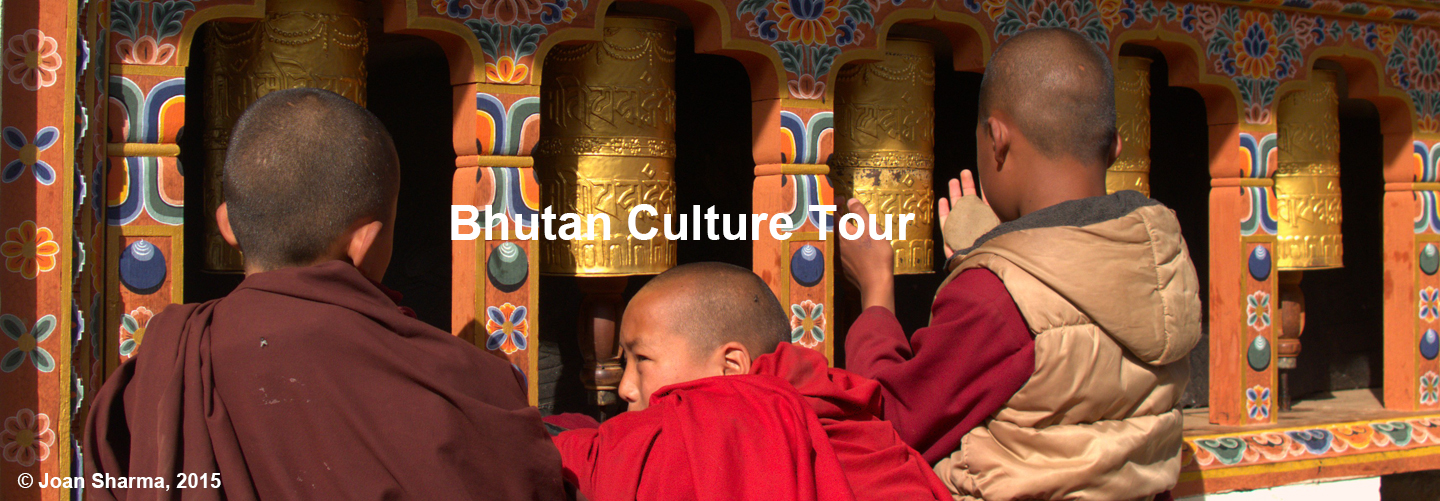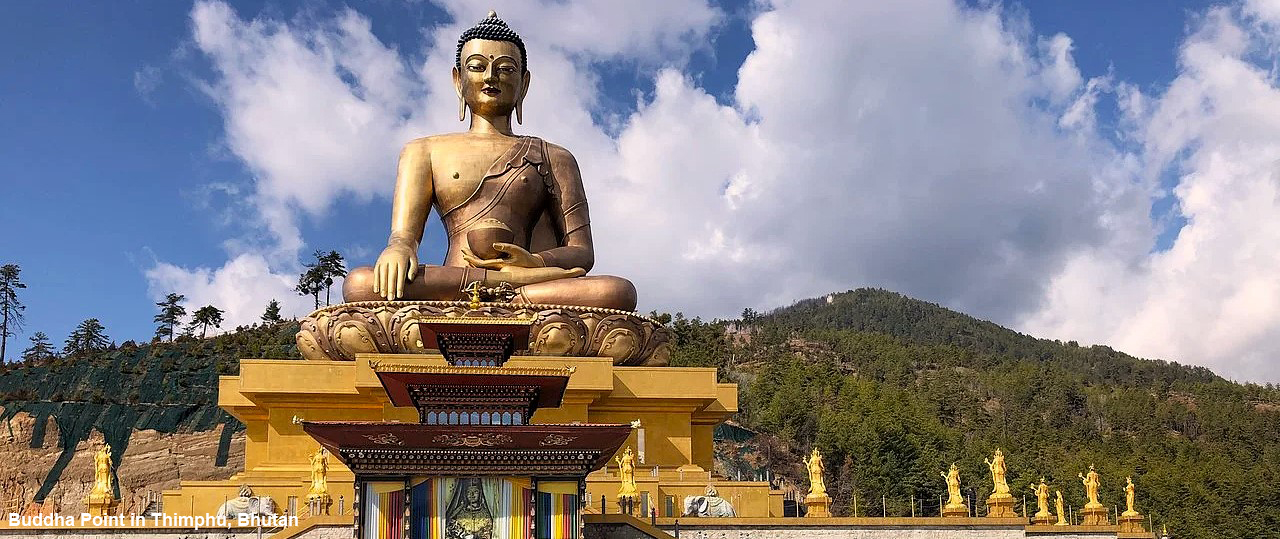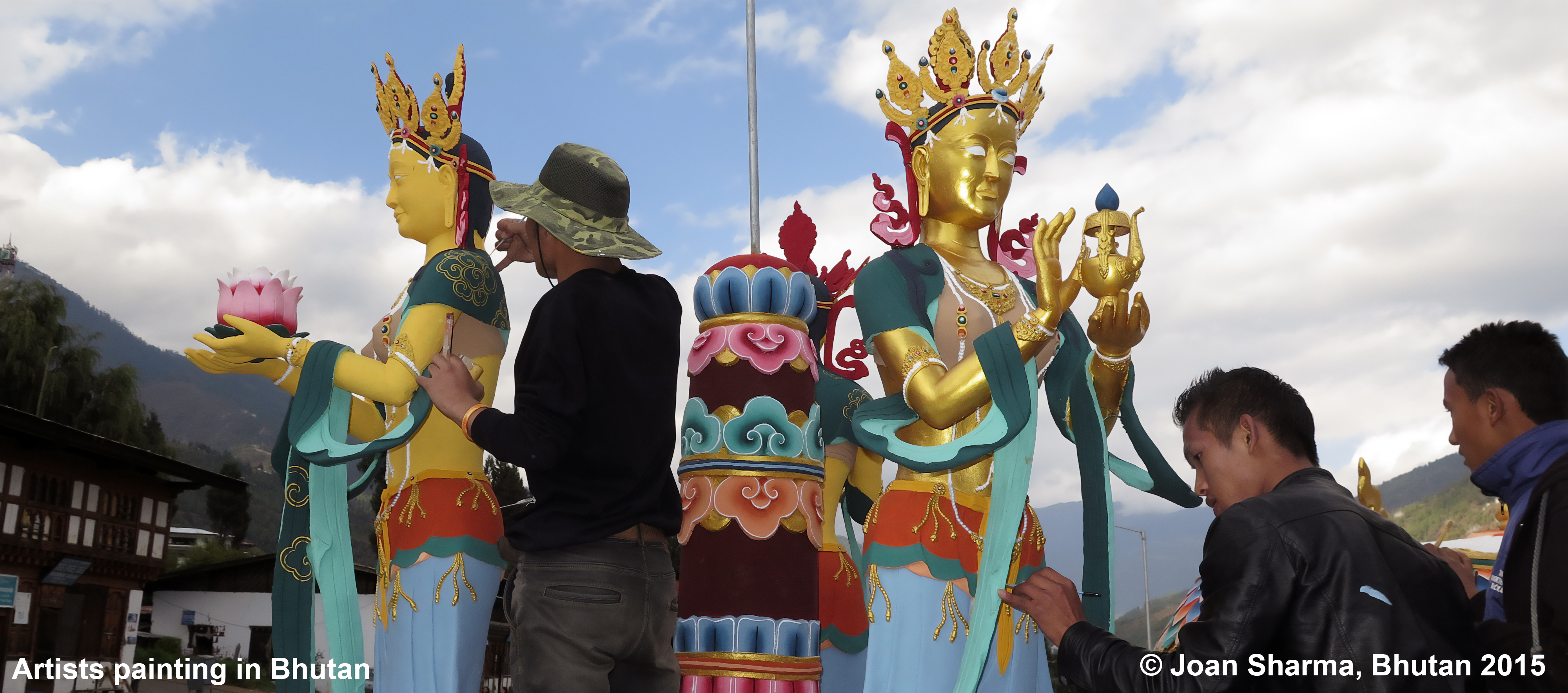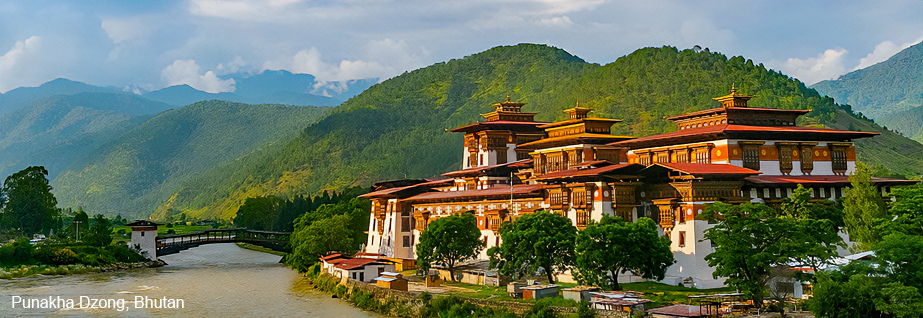Bhutan Culture Tour

The Kingdom of Bhutan is surrounded in the east, south & west by Sikkim, Bengal, Assam and Arunachal Pradesh in India; to its north lies Tibet. The landlocked country of Bhutan is one of the world's most isolated countries and still possesses an unparalleled Vajrayana Buddhist culture, unique customs, mystique and charm for the traveler.
Bhutan is a constitutional monarchy. Until the beginning of 20th. century the country was in political turmoil. In 1907 Ugyen Wangchuk was chosen as hereditary monarch by the country's powerful Buddhist monks, government officials and heads of important families. The British East India Company recognized the new monarch promptly and signed an alliance treaty in 1910. Bhutan was one of the first countries to recognize the newly independent India in August 1947. A friendship treaty was signed with India in August 1949. A 130-member democratic legislative assembly was elected in 1953. Jigme Khesar Namgyel Wangchuk, born on February 21, 1980, was crowned as king of Bhutan in November 2008. He studied in Phillips Academy, Andover; Cushing Academy, Ashburnham in Massachusetts and Wheaton College in llliois, in the United States before completing his studies in foreign service program and international relations from Oxford in UK. He married his childhood friend and India educated, Queen Jelsun Pema, in a very popular, royal wedding ceremony on October 13, 2011, in which very few foreign dignitaries were invited.
Thimpu is the largest city and capital of the kingdom. Bhutanese Ngultrum is the national currency and the Ngultrum is divided in to 100 Chhertums. The currency is equivalent to Indian Rupee in value.

Enjoy the amazing and intriguing museums and Buddhist monasteries in this tiny Himalayan kingdom that are filled with exceptional artifacts, Buddhist Thanka Scrolls, sculptures and religious scriptures. From the time your flight starts approaching Paro throughout the trip every day you will be surrounded by some of the world's most astonishing sites, unique natural landscapes and Bhutan's typical religious and secular architecture. Bhutan's religious calendar is filled with festivals in different regions of the country, please call us to include a festival in your personalized Bhutan itinerary. The festivals are all around the year but in Spring and Fall is the best time to visit Bhutan. Summers are usually rainy and winter with snowfall can be very cold. The Kingdom's only airport is in Paro. As soon as your flight glides towards the airport in the Paro valley you will witness the majestic and breathtaking Himalayan peaks. The pilot will advise you to look for mountains like Mount Everest , Mount Kanchenjunga , Mount Chomolhari & Mount Jechu Drake. Nearer to the Paro valley, you will see Paro Dzong, the magnificent monastic fortress on the hillside overlooking the Pachu (River) and the Ta Dzong (Watchtower) and the National Museum above it.
DAY 1, DELHI - PARO - THIMPHU :
Departure with Drukair from Delhi at 6.35 AM (flights are available from Kolkata and some other cities in India and neighboring countries). Arrival at airport in Paro (altitude: 2,320 meters / 7,656 feet above sea level) at 9.25 AM. The flight into the Himalayas reveals scenic and breathtaking views of Himalayan mountain peaks, the highest in the world. If weather permits you will be able to see Mount Everest (8,848 meters, 29,198 feet) and other majestic Himalayan mountain ranges. Our local representative will greet you on arrival and accompany you to the capital, Thimphu. The drive from Paro airport to Thimpu takes 1.5 hours. After checking into the hotel, the day's sightseeing includes:
Zorig Chusum Institute: The institute was set up by the Bhutanese Government for promoting the 13 traditional arts and crafts of the Himalayan kingdom. The two main objectives of the institute are a) to preserve and promote the traditional arts and crafts and b) to create job opportunities for the underprivileged groups of the society.
Textile museum: It was established with the aim of preserving and promoting Bhutanese textile arts.
Folk Heritage museum: It was inaugurated on July 28, 2001 by Her Majesty the Queen Ashi Dorji Wangmo Wangchuck, who is the founder and patron of the museum. It is dedicated to connecting people to the Bhutanese rural past through exhibition of items and artifacts used in rural households.
Paper factory: The handmade paper making in Bhutan stemmed from the age old tradition that originated in 8th century. The handmade paper making art is a valuable national heritage of Bhutanese cultural identity and is preserved through centuries. The traditional paper is recognized and held in high esteem both at home and abroad.
Mini zoo: Here you can see just one animal - Bhutan’s national animal- the Takin. This is an extremely rare member of the goat family. Found in herds in the very high altitudes (above ,125 feet). They live on a diet of grass and bamboo.
Sangay Gang View Point: The hilltop view point is also the perfect place to take in some truly breathtaking views of the entire city of Thimpu and the valley surrounding it. You will be amazed by the Kuenselcholing hilltop where the largest Buddha idol in the world is being built.
Tashichho Dzong : The name means "Fortress of Glorious Religion". It was built in 1641 by Zhabdrung Ngawang Namgyel. It houses the secretariat building, the throne room and the office of the king, and the central monk body.
In the evening if you wish arrangements to visit the discotheques and entertaining hubs can be made to enjoy the recent evening entertainment trends of the younger Bhutanese. There are live performances of Bhutanese songs and dances (traditional and modern) by the best Bhutanese bands. If you wish you can even test your singing talents in the bars that offer Karaoke.
Overnight in Migmar or similar standard hotel in Thimphu.

DAY 2, THIMPHU
In the one hour roundtrip hike to Cheri and Tango Monastery you will pass by the Dodina and Jigme Dorji Wild Life Sanctuary.
Zhabdrung Ngawang Namgyal built Cheri Dorji Dhen monastery in 1620 and established the first monk body here. You may view rare birds such as Mrs Gould's Sunbird, Yellow-browed Tit, Yellow-rumped Honeyguide, Long-billed Thrush, Ultramarine Flycatcher.
Later visit, the weekend market: Held every Friday, Saturday and Sunday, the people crowd the stalls every day, dressed in full color and gathered to meet and to barter, much like the street markets in London!
Later enjoy the street life in the Himalayan town. Overnight in Migmar or similar hotel in Thimphu.
DAY 3, THIMPHU - TRONGSA :
(Altitude: 2, 200 meters / 7,260 feet above sea level - 6 hour's drive).
Visit the Memorial Chorten in the morning: This Chorten was constructed in 1974 as a memorial for the third King of Bhutan, King Jigme Dorji Wangchuck, who is widely regarded as the father of modern Bhutan. Driving towards Trongsa you will be crossing the Dochula mountain pass (Altitude: 3,140 meters / 10,362 feet above sea-level) and have an awesome, panoramic view of the Himalayan mountain ranges. You will also view the Druk Wangyal Chortens - the 108 Stupas built by the eldest Queen, Her Majesty Ashi Dorji Wangmo Wangchuck. Overnight in Yangkhil Resort or similar in Trongsa.
DAY 4, TRONGSA - BUMTHANG :

(Altitude: 2,600 meters / 8,580 feet above sea level - 3 hour's drive)
Visit the Trongsa Dzong that was built by the Chhogyel Mingyur Tempa. Zhabdrung dispatched him to unify the eastern Bhutan region in the year 1644. The dzong dominates the horizon, dwarfing the surrounding buildings. This Dzong was the administrative capital of the 1st. and 2nd. king of Bhutan. Later visit the Trongsa Museum. On the way to Bumthang Valley stop at the handloom shops and the Swiss farm. Overnight in Wangdicholing Resort or Jakar Village Lodge in Bumthang.

DAY 5, BUMTHANG DAY :
Start the day with the visit to the Jambay Lhakhang, one of the 108 monasteries that King Songtsen Goenpo built in 8th. century CE to subdue the evil spirits in the Himalayan region. Your next stop is the Kurjey Lhakhang which literally means 'body print'. It was built in the 8th. century CE to commemorate the visit of Guru Rimpoche's first visit to Monyul (country in darkness). He introduced the Buddhism to Bhutan. Later hike to Tamzhing Lhakhang (temple of good message) that Terton Pema Lingpa (treasure discoverer) built in 1501 CE. Among the artifacts here are the original paintings made by him and an iron jacket that he constructed. Later view the Mebar Tsho (lake of burning fire) - Bhutanese consider this lake to be sacred because the Pema Lingpa extracted religious treasures from it in the 12th. century CE. Subsequently you will cross the Ura Valley, the highest in Bhutan. The cobbled stone paved streets of the Ura village lend it a medieval look. The older women in this region use the traditional sheepskin shawls that serve as blankets and cushion. Overnight in Wangdicholing Resort or Jakar Village Lodge in Bumthang.

DAY 6, BUMTHANG TO PUNAKHA :
(Altitude: 1,350 meters / 4,455 feet above sea level - 6.5 hour's drive). This is a full day's spectacular drive through one of the most scenic routes in Bhutan with opportunities to view rare animals and birds on the way.Later stroll around the city. Overnight in Punatsangchu Cottages or similar in Punakha.
DAY 7, PUNAKHA TO PARO :
(Altitude: 2,280 meters / 7,524 feet above sea level - 4.5 hour's drive) In the morning visit Punakha, later in the afternoon visit, Punakha Dzong (fortress): Built in 1637 CE by Zhabdrung which is remarkably located between the rivers of Mo (Female) Chu (river) and Pho (Male) Chu. Until the time of second king it served as a seat of the king. The recent royal wedding of the King of Bhutan took place in this dzong.
Chimi Lhakhang (Temple of fertility): This Temple was built by lam Drukpa Kuenley (The Divine Madman) in 1499. It is about thirty minutes hike across fields from the road –Wooden phalluses are often found hanging in the four corners of the houses and also phalluses are painted on the walls of houses. It is the common belief that this helps in driving away evil spirits.
Later drive to Paro valley and visit, Ta Dzong: This served as a watch tower during the 17th century CE to guard the region from the Tibetan invasion. It was converted to the National Museum in 1968.
Kichu Lhakhang (Monastery): It is one of the two most sacred and the oldest temples in Bhutan. It was built in 7th century by Tibetan King Songtsen Gampo. Overnight in Tashi Namgae Resort or similar in Paro.
DAY 8, PARO :
Enjoy this morning a 1.5 hour hike to the Taktsang Monastery (Tiger's nest), perched on a 800 Meters or 2,640 feet high sheer cliff. The return to the valley is another 1.5 hour hike. Taktsang symbolizes the place where the 8th. Century CE Indian mystic, Guru Padmasambhava, arrived on a flying tiger and meditated after bringing Buddhism to Bhutan. This is one of the highlights of the trip to Bhutan. This monastery was tragically and mysteriously consumed by fire in April 1998 but it has now been fully restored to its former glory.
Visit a Farmhouse: You will get to experience Bhutanese cuisine. Enjoy a hot stone bath that is very refreshing after the morning hike. The house visit also shows you for the first time the interior of a typical Bhutanese house. Later get a feel of local life in the market streets.
In the afternoon stroll around the town and see how locals live. There will be a farewell dinner tonight. Overnight in Tashi Namgae Resort or similar in Paro
DAY 9, PARO - DELHI :
Early breakfast at the hotel drive to the airport for boarding your return flight. Your escort will assist you with exit formalities and bid you farewell.
For price & flight connections from Delhi, Kolkata and Bangkok please call 1-559-446-0499.
Inclusions :
- Accommodation with breakfast in 3 and 4 star hotels approved by Tourism Council of Bhutan and Hotel Association of Bhutan for 8 overnights / 9 days (for 5-star hotels please call)
- All meals (lunch and dinner in local tourist restaurants and hotels).
- Experienced English speaking tour guide licensed by Tourism Council of Bhutan.
- Private transport within Bhutan with chauffeur.
- Face masks required for travelers in public areas.
- Face masks required for guides and staff in public areas.
- Hand sanitizer available for travelers and staff.
- Regularly sanitized high-traffic areas.
- Gear and equipment sanitized between use.
- Transportation vehicles sanitized between use.
- Guides and staff required to regularly wash hands.
- Temperature control for guides and staff.
- Entrance fee for museums & monuments.
- Mineral water in car.
- Government royalty.
- Tourism Development Fund.
CASH & CREDIT CARDS :
Cash transactions can generally be made in either U.S. dollars or local currency. U.S. dollars should be recently issued bills in smaller denominations. The import and export of Indian Rupees is strictly prohibited unless you are a resident of India. So make certain to conduct any currency exchanges within India. Major credit cards are accepted on a limited basis, mainly in the larger shops, hotels and restaurants. Access to ATM machines is widespread in cities and towns but limited in rural areas.
Exclusions :
For India: All travellers, regardless of age, must present an original COVID-19 vaccination certificate indicating full vaccination completed at least 15 days prior to arrival. The current approved vaccines are Pfizer (Comirnaty), Moderna (Spikevax) and AstraZeneca (Vaxzevria) and Janssen/Johnson & Johnson (Ad26.COV2.S). To meet changing requirements, a booster shot is recommended.
In accordance with local regulations, face masks must be worn in public areas, including hotels and outdoor spaces where physical distancing of at least 6 feet (2 meters) cannot be maintained. We encourage you to bring your own masks; a supply will be on hand where needed. Note all protocols are subject to change in accordance with relevant guidelines, local regulations and conditions.
- Bhutan Visa fee USD 20 per Person.
- International airfare including airfare from Delhi, Kolkata, Bangkok or Kathmandu to Paro in Bhutan. We will be glad to book these flights as per your schedule at the best available fare.
- Gratuities and personal expenses like bar, telephone, laundry bills etc.
PAYMENT :
Payments can be made by personal check in favor of INDIA TRAVELLER or by PAYPAL.


